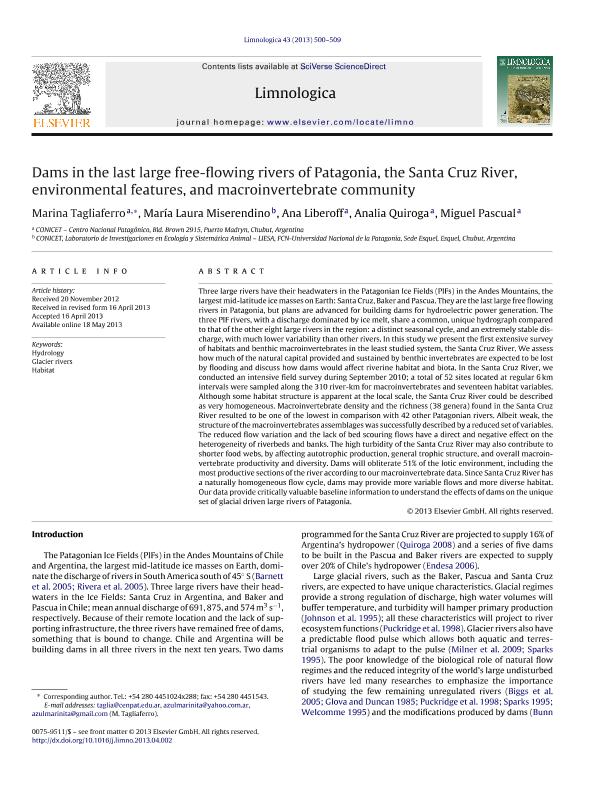Artículo
Dams in the last large free-flowing rivers of Patagonia, the Santa Cruz River, environmental features, and macroinvertebrate community
Tagliaferro, Marina Beatriz ; Miserendino, Maria Laura
; Miserendino, Maria Laura ; Liberoff, Ana Laura
; Liberoff, Ana Laura ; Quiroga, Analía Pamela
; Quiroga, Analía Pamela ; Pascual, Miguel Alberto
; Pascual, Miguel Alberto
 ; Miserendino, Maria Laura
; Miserendino, Maria Laura ; Liberoff, Ana Laura
; Liberoff, Ana Laura ; Quiroga, Analía Pamela
; Quiroga, Analía Pamela ; Pascual, Miguel Alberto
; Pascual, Miguel Alberto
Fecha de publicación:
05/2013
Editorial:
Elsevier
Revista:
Limnologica
ISSN:
0075-9511
Idioma:
Inglés
Tipo de recurso:
Artículo publicado
Clasificación temática:
Resumen
Three large rivers have their headwaters in the Patagonian Ice Fields (PIFs) in the Andes Mountains, thelargest mid-latitude ice masses on Earth: Santa Cruz, Baker and Pascua. They are the last large free flowingrivers in Patagonia, but plans are advanced for building dams for hydroelectric power generation. Thethree PIF rivers, with a discharge dominated by ice melt, share a common, unique hydrograph comparedto that of the other eight large rivers in the region: a distinct seasonal cycle, and an extremely stable dis-charge, with much lower variability than other rivers. In this study we present the first extensive surveyof habitats and benthic macroinvertebrates in the least studied system, the Santa Cruz River. We assesshow much of the natural capital provided and sustained by benthic invertebrates are expected to be lostby flooding and discuss how dams would affect riverine habitat and biota. In the Santa Cruz River, weconducted an intensive field survey during September 2010; a total of 52 sites located at regular 6 kmintervals were sampled along the 310 river-km for macroinvertebrates and seventeen habitat variables.Although some habitat structure is apparent at the local scale, the Santa Cruz River could be describedas very homogeneous. Macroinvertebrate density and the richness (38 genera) found in the Santa CruzRiver resulted to be one of the lowest in comparison with 42 other Patagonian rivers. Albeit weak, thestructure of the macroinvertebrates assemblages was successfully described by a reduced set of variables.The reduced flow variation and the lack of bed scouring flows have a direct and negative effect on theheterogeneity of riverbeds and banks. The high turbidity of the Santa Cruz River may also contribute toshorter food webs, by affecting autotrophic production, general trophic structure, and overall macroin-vertebrate productivity and diversity. Dams will obliterate 51% of the lotic environment, including themost productive sections of the river according to our macroinvertebrate data. Since Santa Cruz River hasa naturally homogeneous flow cycle, dams may provide more variable flows and more diverse habitat.Our data provide critically valuable baseline information to understand the effects of dams on the uniqueset of glacial driven large rivers of Patagonia.
Palabras clave:
Hydrology
,
Glacier Rivers
,
Habitat
Archivos asociados
Licencia
Identificadores
Colecciones
Articulos(CCT-CENPAT)
Articulos de CTRO.CIENTIFICO TECNOL.CONICET - CENPAT
Articulos de CTRO.CIENTIFICO TECNOL.CONICET - CENPAT
Citación
Tagliaferro, Marina Beatriz; Miserendino, Maria Laura; Liberoff, Ana Laura; Quiroga, Analía Pamela; Pascual, Miguel Alberto; Dams in the last large free-flowing rivers of Patagonia, the Santa Cruz River, environmental features, and macroinvertebrate community; Elsevier; Limnologica; 43; 6; 5-2013; 500-509
Compartir
Altmétricas



